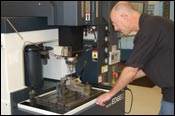It is important and necessary to implement new technologies or services, but not always sufficient to bring bottom-line benefits, unless you fully understand the potential benefits of what you’re considering. Photo Credit, all images: Getty Images
Technology typically enables us to do more stuff faster, which is generally a good thing. However, it does not necessarily lead to more sales, reduced operating expenses or reduced inventory. And these are the factors that determine how much money we make, whether we are talking about new machines, a new ERP system, 3D printing or any other technology.
Technology is necessary but not always sufficient to help you make more money. This is why we have a saying in Theory of Constraints: “Technology is necessary but not sufficient,” a prominent theme in Eliyahu M. Goldratt’s book, Necessary But Not Sufficient.
Breaking Down Technology Investment
Technology can bring benefits if, and only if, it diminishes a limitation. This does not mean that if technology diminishes a limitation, it necessarily brings benefits; only that it can or may bring benefits. The statement holds true even if the limitation is not recognized (you are not aware of it).
Long before the availability of a technology, we developed modes of behavior, policies, procedures, measures and rules to help us accommodate whatever limitations we have in our system. As a result, our systems do a nice job of accommodating existing limitations.
Success with new technology is about changing the rules.
So, what benefit will any technology bring if we neglect to change the rules? If we keep doing things the same way, only faster, what benefit will there be? Sometimes the answer is none. If we obey the same rules, we are acting as if the limitation is still there and is still being limiting.
How many shops do you know that have implemented technology of some kind, and as a result, their profits have increased substantially? On the other hand, how many shops do you know that have implemented technology and have had no results? Now, tell me which of these scenarios is more common.
If you want to make sure that your technology investments pay off, here are four questions to ask to ensure that good technology — once implemented — will bring bottom-line benefits:
1. What is the main power of the technology?
2. What limitation does this technology diminish?
3. What rules helped us to accommodate the limitation?
4. What rules should we use now (with this new technology)?
Shops must answer these four questions to fully understand and gain the potential benefit of any technology you are considering.
Since most of you schedule your shop daily, let’s look at an example using the Velocity Scheduling System (VSS) as the new technology. (Note: We’re a little extreme in an attempt to add humor as you continue reading.)
1. What is the main power of the technology? (In this case, the VSS.)
Technology teaches how to improve shop communications and communications between manufacturing and sales.
- It focuses on flow that reduces lead times and increases output with the same people and resources (increasing net profits).
- It is a visual scheduling and priority system so that at a glance you can see which jobs are the highest priority jobs and everyone knows what to work on.
- It provides a system to reduce and control work in progress (WIP), which reduces lead time.
- It teaches you how to improve shop communications and the communications between manufacturing and sales.
- It includes a planning component to help determine the release order of jobs and when you need to add capacity to ensure due date performance now and in the future.
- It includes a continuous improvement component so that your velocity gets faster and faster and you know what one improvement project you should be doing.
- It includes critical operational and financial metric monitoring (six metrics total) to ensure that your throughput margin is growing faster than your operating expenses while maintaining or improving lead times and due date performance.
2. What limitation does this technology diminish?
- Not shipping enough.
- The need to constantly update and redo the shop schedule and/or change the promised due dates.
- The need to add capacity before fully leveraging what you have because you don’t really know what you need.
- The need to call customers and change due dates or beg for forgiveness.
- The need to improve everywhere because you don’t know where to improve to have the biggest bottom-line effect.
- The need to have a kazillion key indicators.
- The need to limit profits by what you can get out the door, or the need to limit the new business you go after because you can’t deliver on time what you already have.
Technology can bring benefits if and only if it diminishes a limitation.
3. What rules (or behaviors) helped us to accommodate the limitation?
- Just keep everyone and/or every machine busy all the time, maximizing the use of resources and efficiencies. And if you are efficient, you are doing the best you can.
- To increase the likelihood that everyone has something to do, ensure all orders are available to be worked on.
- When an important customer calls or an important job is in jeopardy of being late, change priorities in the shop. But also run around and create lots of chaos and stress for everyone.
- Whenever you have a little cash, buy new machines. You like new machines. (I have been in a number of shops where they buy equipment if they get a little cash. I’m not saying you do this, but it does happen.)
- Reduce waste (apply lean) everywhere. Reduce variability (apply Six Sigma) everywhere. And brainstorm a long list of improvement projects.
- Detail schedule. Schedule when every job will be on every piece of equipment, then reschedule and reschedule as you get hit with the reality and complexity of running a custom shop.
- Measure as much as possible — track time on every task on every job. Collect tons of bad data. (If you just had more data, you could improve your scheduling and get more on time.)
Success with new technology is about changing the rules and thinking differently regarding how to address those limitations.
4. What rules should we use now (with this new technology)?
- Reduce and control WIP. Stop releasing all the work to the floor to increase the likelihood that everyone has something to do.
- Work that is waiting its turn to be released — get a “full kit” for it.
- Use the rules of the Velocity Scheduling System to deal with things like emergencies and customer changes.
- Measure flow, not efficiencies and don’t worry about keeping everyone busy.
- Green/Yellow/Red is your one and only priority system. The Velocity Board communicates what to do.
- You do not detail schedule (stop adding detail).
- You focus on finishing what you started rather than starting more stuff.
- You use buffers to absorb and manage the variability and mix changes that occur in complex shops.
- You track the major disruptions to flow and use those to direct your continuous improvement so that you know what one improvement project you should be doing. Stop brainstorming lists or trying to improve everywhere. Instead, the system will tell you where to focus your continuous improvement efforts.
- You only add capacity (buy machines) at the place that is the number one disruption to flow (or for strategic reasons). If it’s not disrupting flow, you do not need more or better stuff.
- Focus and flow are the names of the game, not efficiencies and cost.
Suppose you implemented the VSS with a complete understanding of the limitations you were addressing and the rules and behaviors you needed to change. Would the likelihood of a bottom-line improvement increase? Suppose you used this process to evaluate VSS along with other potential solutions. Might you have a better chance of choosing the best solution to whatever limitation you were trying to address?
Success with new technology is about changing the rules. It’s about thinking differently regarding how to address those limitations. But unfortunately, doing the same things faster typically doesn’t lead to bottom-line results.
Remember, if a technology does not diminish a true limitation that you really have, then you are not likely to get a bottom-line result. We are not against new technology. VSS is a type of new technology. We’re against spending money on any technology that does not lead to bottom-line results.
Related Content
Mold Builder Uses Counter-Intuitive Approach for Mold Challenges
Matrix Tool Inc. answers customers’ hard questions with creative solutions for cavity spacing, tool sizing, runner layout and melt delivery that reveal the benefits of running in a smaller press size at lower cavitation but higher yield.
Read MoreThe Role of Social Media in Manufacturing
Charles Daniels CFO of Wepco Plastics shares insights on the role of social media in manufacturing, how to improve the “business” side of a small mold shop and continually developing culture.
Read MoreThe Trifecta of Competitive Toolmaking
Process, technology and people form the foundations of the business philosophy in place at Eifel Mold & Engineering.
Read MoreMold Design Review: The Complete Checklist
Gerardo (Jerry) Miranda III, former global tooling manager for Oakley sunglasses, reshares his complete mold design checklist, an essential part of the product time and cost-to-market process.
Read MoreRead Next
Constraint Management: How to Break a Roadblock
Learning how to get the most out of what your shop has today.
Read MoreFour-Step Formula for Mold Builders to Use in Their Marketing That Increases Sales
The most common marketing mistakes, some key marketing questions to land new business and how the Theory of Constraints applies to marketing within the small to midsize manufacturer.
Read MoreAre You a Moldmaker Considering 3D Printing? Consider the 3D Printing Workshop at NPE2024
Presentations will cover 3D printing for mold tooling, material innovation, product development, bridge production and full-scale, high-volume additive manufacturing.
Read More
























.png;maxWidth=300;quality=90)







